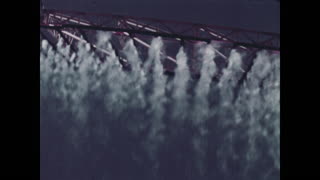Marines in Vietnam fighting a hidden enemy who holds life cheaply. The Marines are fighting a ground and air war. Casualties of war. The American soldiers walk through the rivers looking for the Viet Cong. 0:19:14-58:21. The American Commanders are intent on leading their ground forces to ultimate victory. Wings for the Ground Commander. 1:22-1:44 The USMC prepare to attack the enemy stronghold and experience the sounds of war first hand thanks to an American military correspondent. The Viet Cong are attacking – you can hear them, but you can’t see them. We listen to the sounds of war. Attacks for 10 minutes from the village and still no one in sight. The US troops are continually searching for tunnels, caves; the Viet Cong hideouts. All hell breaks loose. 1:50:-3:01 The Sea Knight evacuation sequence. 3:40-4:00. The ground commander makes all his strategic military plans depending on the availability of these mighty transport helicopters. The Sea Knight has a tandem rotor design. 4:05 Office sequence with engineers and models depicting the design of the Sea Knight. The blades counter-rotate to offset torque. Small trucks, trailers and artillery can be loaded easily through the back ramp. Fuselage measurements (24’ x 6’ x 6’). 850 feet of cargo space. 4:12-4:40. The winch on the Sea Knight pulls on equipment at speeds up to 30 feet per minute. 4:54-4:58
Two 100 nautical mile missions at sea levels under normal conditions are engaged to define and refine the Sea Knights capabilities. The first is an assault and supply mission of 17 men comprising 4,000 pounds of cargo. The second, a medivac mission with medical personnel on board. MediVac. 5:05-5:25
Extensive testing of the Sea Knight. 5:32-5:35. Landing demonstration. Amphibious capability with ability to take off on a single engine, if necessary. 5:50-5:57. Ice protection shields. 6:04-6:15. The Sea Knight has been tested so that it can operate anywhere in the world. 6:28-6:40. External cargo hook tested in the field before military action. 6:43-6:50. The Sea Knight is the quickest way to supply troops in the field. Some models were designed for LPH Carriers, able to fold or unfold its blades in less than a minute – in 45 mile per hour winds, if required. 7:13-7:16
Para-jump mission at from the rear ramp. 7:17-7-25. Hydraulic and utility systems are reviewed. 8:00-8:30 Sea Knight is independent of outside power sources. Sea Knights and their pilots arrive tested and prepared when arriving in Vietnam. Sea Knight salvaging downed aircraft. 9:44-10:00. The Sea Knight saves the military millions of dollars with each piece of equipment it retrieves. Primary mission of the Sea Knight is the rapid deployment of troops, artillery and supplies. 11:10-11:17 Men riding into battle in the tandem rotor helicopters, envelope the enemy. To the marine, the Sea Knight means critical mobile support. To the commander it helps him outline a vertical deployment strategy. 12:45-13:00.
Boeing Vertol CH-46 Sea Knight is a medium-lift tandem-rotor transport helicopter powered by twin turboshaft engines. It was designed by Vertol and manufactured by Boeing Vertol following Vertol’s acquisition by Boeing. During 1961, the US Marine Corps (USMC), who had been studying its requirements for a medium-lift, twin-turbine cargo/troop assault helicopter, selected Boeing Vertol’s Model 107M as the basis from which to manufacture a suitable rotorcraft to meet their needs. Known colloquially as the “Phrog” and formally as the “Sea Knight”, it was operated across all US Marine Corps’ operational environments between its introduction during the Vietnam War and its frontline retirement during 2014. The Sea Knight was operated by the USMC to provide all-weather, day-or-night assault transport of combat troops, supplies and equipment until it was replaced by the MV-22 Osprey during the 2010s. The USMC also used the helicopter for combat support, search and rescue (SAR), casualty evacuation and Tactical Recovery of Aircraft and Personnel (TRAP). The Sea Knight also functioned as the US Navy’s standard medium-lift utility helicopter prior to the type being phased out of service in favor of the MH-60S Knighthawk during the early 2000s. The commercial version of the rotorcraft is the BV 107-II, referred to simply as the “Vertol”.
We encourage viewers to add comments and, especially, to provide additional information about our videos by adding a comment! See something interesting? Tell people what it is and what they can see by writing something for example: “01:00:12:00 — President Roosevelt is seen meeting with Winston Churchill at the Quebec Conference.”
This film is part of the Periscope Film LLC archive, one of the largest historic military, transportation, and aviation stock footage collections in the USA. Entirely film backed, this material is available for licensing in 24p HD, 2k and 4k. For more information visit http://www.PeriscopeFilm.com


